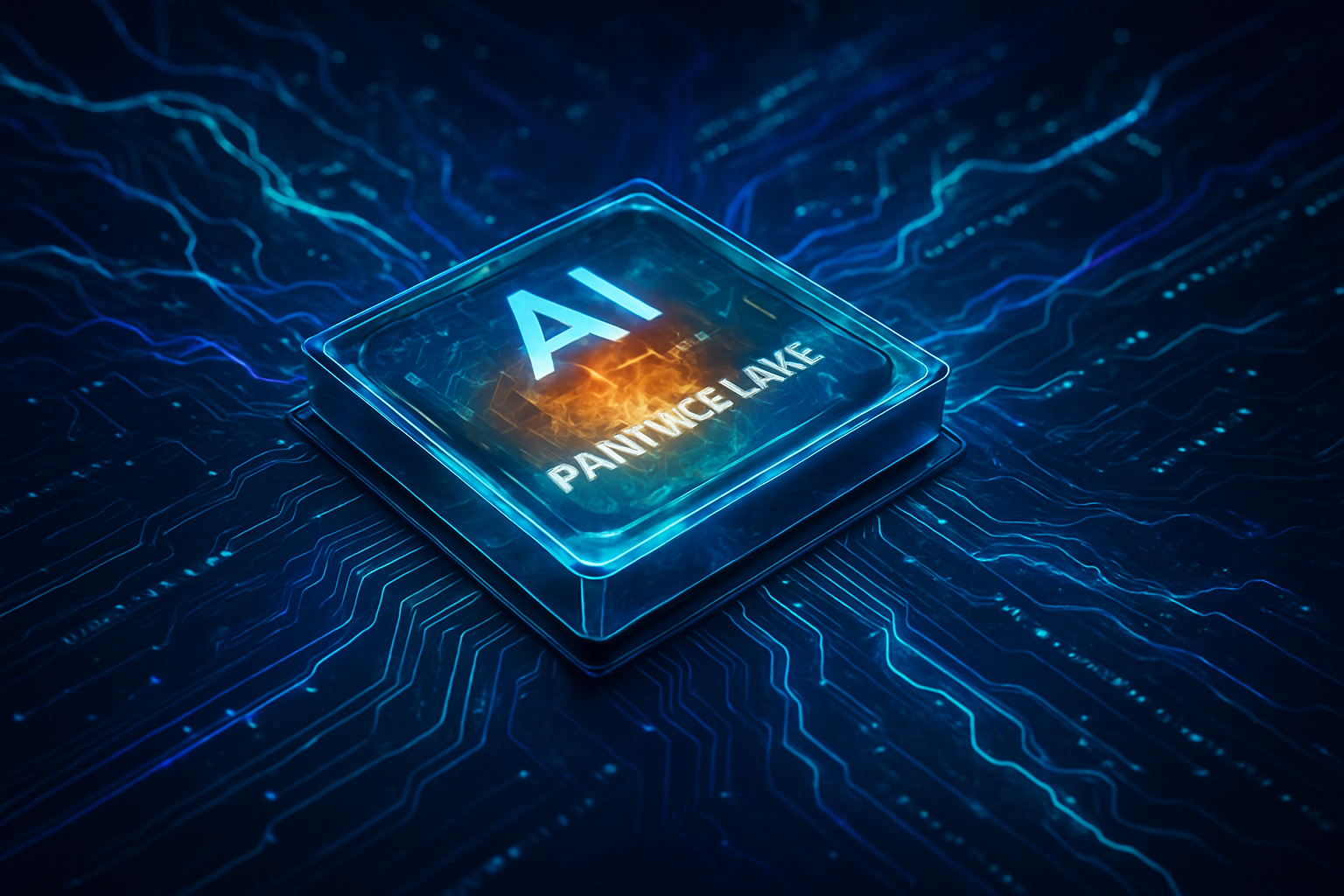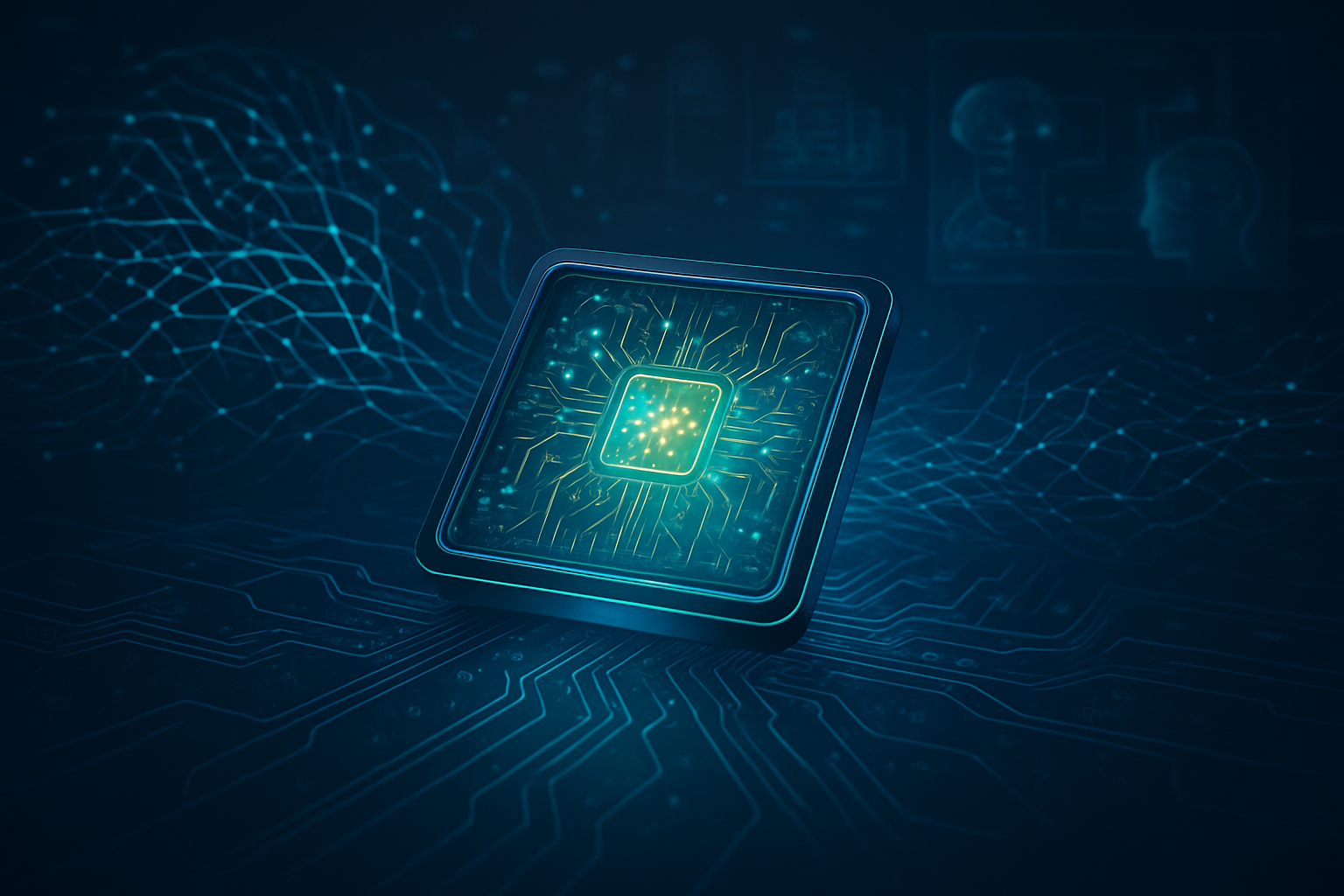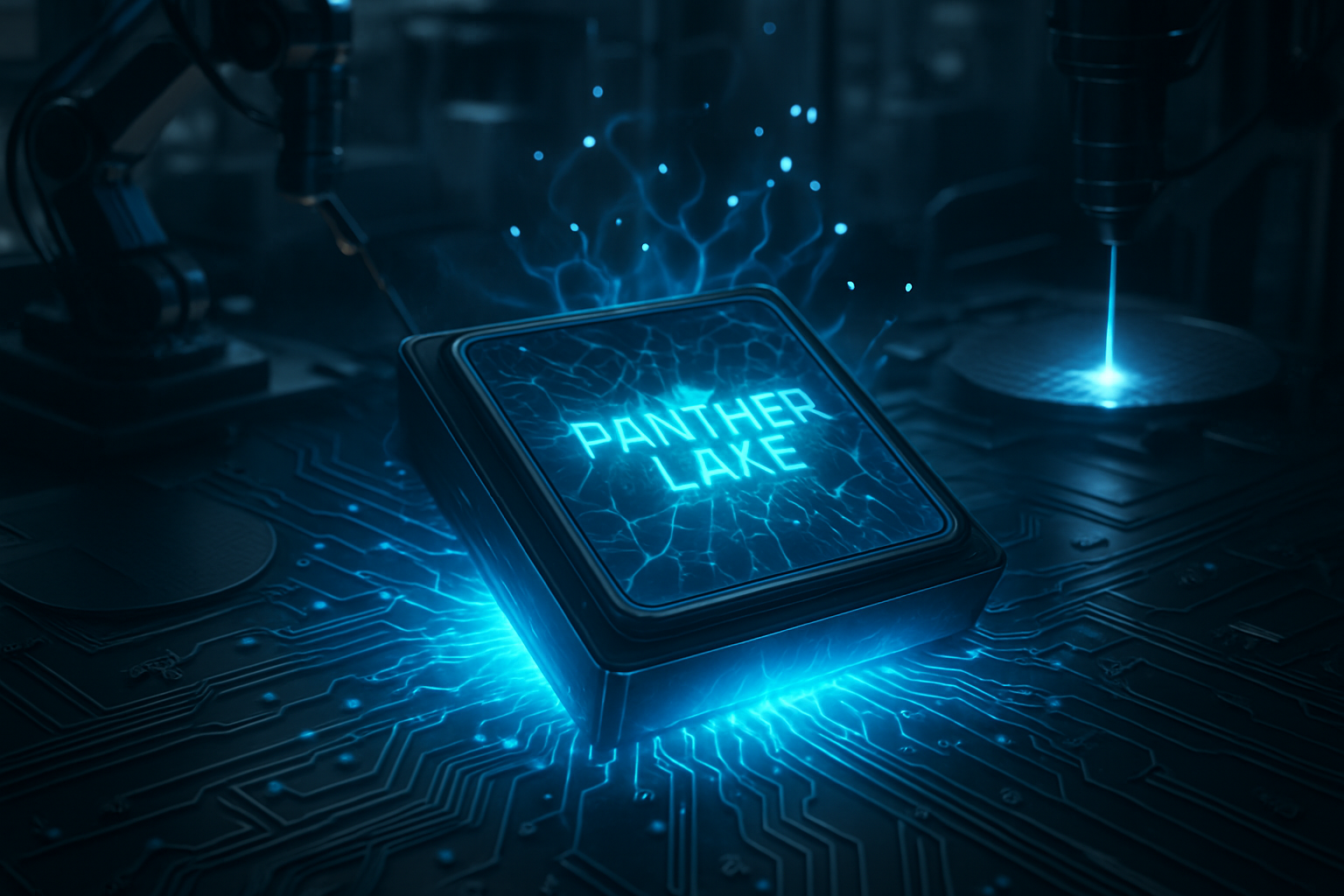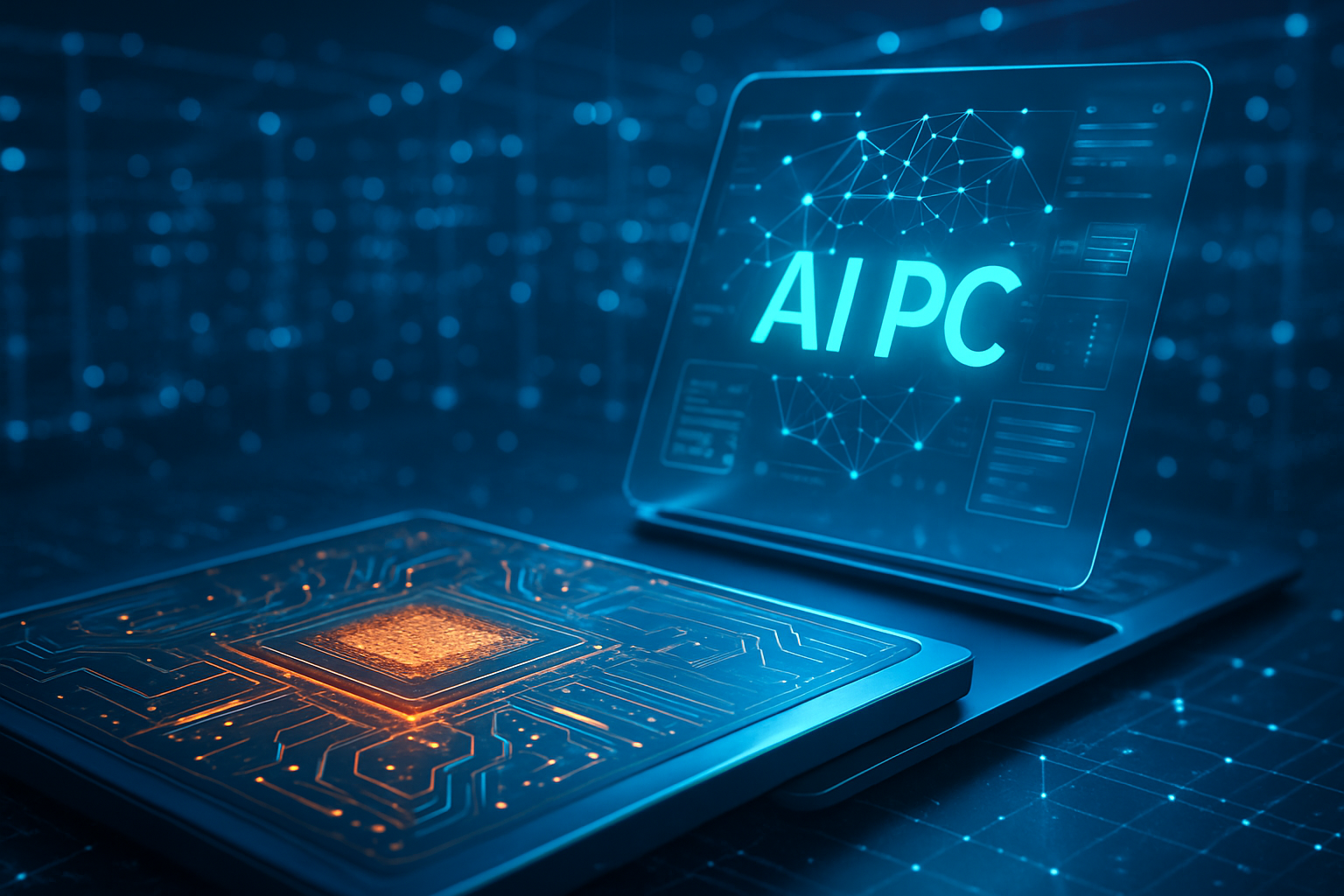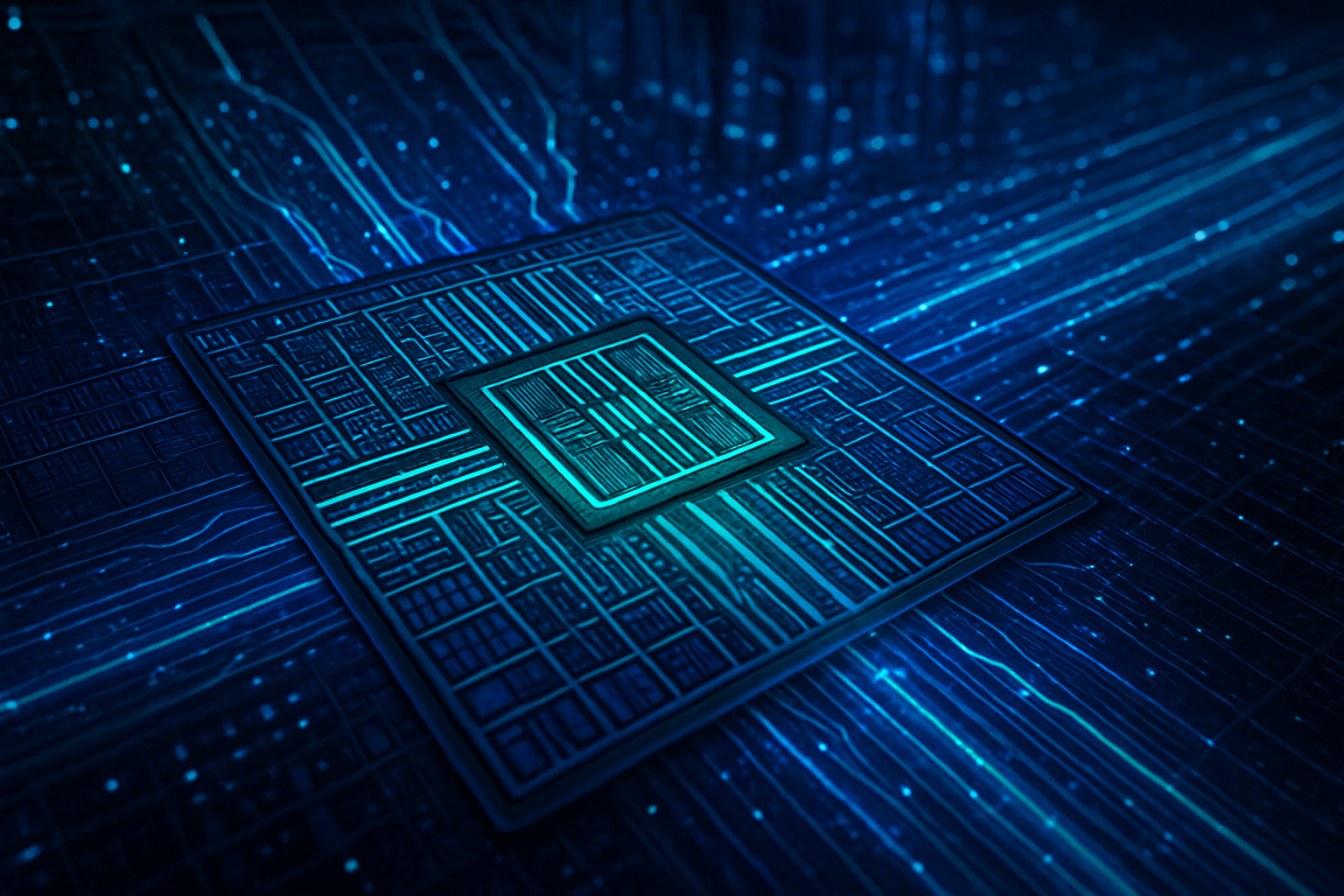Santa Clara, CA – October 10, 2025 – Intel Corporation (NASDAQ: INTC) has officially taken a bold leap into the future of artificial intelligence with the architectural unveiling of its 'Panther Lake' AI chips, formally known as the Intel Core Ultra Series 3. Announced on October 9, 2025, these processors represent the cornerstone of Intel's ambitious "IDM 2.0" comeback strategy, a multi-billion-dollar endeavor aimed at reclaiming semiconductor leadership by the middle of the decade. Positioned to power the next generation of AI PCs, gaming devices, and critical edge solutions, Panther Lake is not merely an incremental upgrade but a fundamental shift in Intel's approach to integrated AI acceleration, signaling a fierce battle for dominance in an increasingly AI-centric hardware landscape.
This strategic move comes at a pivotal time for Intel, as the company grapples with intense competition and investor scrutiny. The success of Panther Lake is paramount to validating Intel's approximately $100 billion investment in expanding its domestic manufacturing capabilities and revitalizing its technological prowess. While the chips promise unprecedented on-device AI capabilities and performance gains, the market remains cautiously optimistic, with a notable dip in Intel's stock following the announcement, underscoring persistent skepticism about the company's ability to execute flawlessly against its ambitious roadmap.
The Technical Prowess of Panther Lake: A Deep Dive into Intel's AI Engine
At the heart of the Panther Lake architecture lies Intel's groundbreaking 18A manufacturing process, a 2-nanometer-class technology that marks a significant milestone in semiconductor fabrication. This is the first client System-on-Chip (SoC) to leverage 18A, which introduces revolutionary transistor and power delivery technologies. Key innovations include RibbonFET, Intel's Gate-All-Around (GAA) transistor design, which offers superior gate control and improved power efficiency, and PowerVia, a backside power delivery network that enhances signal integrity and reduces voltage leakage. These advancements are projected to deliver 10-15% better power efficiency compared to rival 3nm nodes from TSMC (NYSE: TSM) and Samsung (KRX: 005930), alongside a 30% greater transistor density than Intel's previous 3nm process.
Panther Lake boasts a robust "XPU" design, a multi-faceted architecture integrating a powerful CPU, an enhanced Xe3 GPU, and an updated Neural Processing Unit (NPU). This integrated approach is engineered to deliver up to an astonishing 180 Platform TOPS (Trillions of Operations Per Second) for AI acceleration directly on the device. This capability empowers sophisticated AI tasks—such as real-time language translation, advanced image recognition, and intelligent meeting summarization—to be executed locally, significantly enhancing privacy, responsiveness, and reducing the reliance on cloud-based AI infrastructure. Intel claims Panther Lake will offer over 50% faster CPU performance and up to 50% faster graphics performance compared to its predecessor, Lunar Lake, while consuming more than 30% less power than Arrow Lake at similar multi-threaded performance levels.
The scalable, multi-chiplet (or "tile") architecture of Panther Lake provides crucial flexibility, allowing Intel to tailor designs for various form factors and price points. While the core CPU compute tile is built on the advanced 18A process, certain designs may incorporate components like the GPU from external foundries, showcasing a hybrid manufacturing strategy. This modularity not only optimizes production but also allows for targeted innovation. Furthermore, beyond traditional PCs, Panther Lake is set to extend its reach into critical edge AI applications, including robotics. Intel has already introduced a new Robotics AI software suite and reference board, aiming to facilitate the development of cost-effective robots equipped with advanced AI capabilities for sophisticated controls and AI perception, underscoring the chip's versatility in the burgeoning "AI at the edge" market.
Initial reactions from the AI research community and industry experts have been a mix of admiration for the technical ambition and cautious optimism regarding execution. While the 18A process and the integrated XPU design are lauded as significant technological achievements, the unexpected dip in Intel's stock price on the day of the architectural reveal highlights investor apprehension. This sentiment is fueled by high market expectations, intense competitive pressures, and ongoing financial concerns surrounding Intel's foundry business. Experts acknowledge the technical leap but remain watchful of Intel's ability to translate these innovations into consistent high-volume production and market leadership.
Reshaping the AI Landscape: Competitive Implications and Market Dynamics
Intel's Panther Lake chips are poised to send ripples across the AI industry, fundamentally impacting tech giants, emerging AI companies, and startups alike. The most direct beneficiary is Intel (NASDAQ: INTC) itself, as these chips are designed to be its spearhead in regaining lost ground in the high-end mobile processor and client SoC markets. The emphasis on "AI PCs" signifies a strategic pivot, aiming to redefine personal computing by integrating powerful on-device AI capabilities, a segment expected to dominate both enterprise and consumer computing in the coming years. Edge AI applications, particularly in industrial automation and robotics, also stand to benefit significantly from Panther Lake's enhanced processing power and specialized AI acceleration.
The competitive implications for major AI labs and tech companies are profound. Intel is directly challenging rivals like Advanced Micro Devices (NASDAQ: AMD), which has been steadily gaining market share with its Ryzen AI processors, and Qualcomm Technologies (NASDAQ: QCOM), whose Snapdragon X Elite chips are setting new benchmarks for efficiency in mobile computing. Apple Inc. (NASDAQ: AAPL) also remains a formidable competitor with its highly efficient M-series chips. While NVIDIA Corporation (NASDAQ: NVDA) continues to dominate the high-end AI accelerator and HPC markets with its Blackwell and H100 GPUs—claiming an estimated 80% market share in Q3 2025—Intel's focus on integrated client and edge AI aims to carve out a distinct and crucial segment of the AI hardware market.
Panther Lake has the potential to disrupt existing products and services by enabling a more decentralized and private approach to AI. By performing complex AI tasks directly on the device, it could reduce the need for constant cloud connectivity and the associated latency and privacy concerns. This shift could foster a new wave of AI-powered applications that prioritize local processing, potentially impacting cloud service providers and opening new avenues for startups specializing in on-device AI solutions. The strategic advantage for Intel lies in its ambition to control the entire stack, from manufacturing process to integrated hardware and a burgeoning software ecosystem, aiming to offer a cohesive platform for AI development and deployment.
Market positioning for Intel is critical with Panther Lake. It's not just about raw performance but about establishing a new paradigm for personal computing centered around AI. By delivering significant AI acceleration capabilities in a power-efficient client SoC, Intel aims to make AI an ubiquitous feature of everyday computing, driving demand for its next-generation processors. The success of its Intel Foundry Services (IFS) also hinges on the successful, high-volume production of 18A, as attracting external foundry customers for its advanced nodes is vital for IFS to break even by 2027, a goal supported by substantial U.S. CHIPS Act funding.
The Wider Significance: A New Era of Hybrid AI
Intel's Panther Lake chips fit into the broader AI landscape as a powerful testament to the industry's accelerating shift towards hybrid AI architectures. This paradigm combines the raw computational power of cloud-based AI with the low-latency, privacy-enhancing capabilities of on-device processing. Panther Lake's integrated XPU design, with its dedicated NPU, CPU, and GPU, exemplifies this trend, pushing sophisticated AI functionalities from distant data centers directly into the hands of users and onto the edge of networks. This move is critical for democratizing AI, making advanced features accessible and responsive without constant internet connectivity.
The impacts of this development are far-reaching. Enhanced privacy is a major benefit, as sensitive data can be processed locally without being uploaded to the cloud. Increased responsiveness and efficiency will improve user experiences across a multitude of applications, from creative content generation to advanced productivity tools. For industries like manufacturing, healthcare, and logistics, the expansion of AI at the edge, powered by chips like Panther Lake, means more intelligent and autonomous systems, leading to greater operational efficiency and innovation. This development marks a significant step towards truly pervasive AI, seamlessly integrated into our daily lives and industrial infrastructure.
However, potential concerns persist, primarily centered around Intel's execution capabilities. Despite the technical brilliance, the company's past missteps in manufacturing and its vertically integrated model have led to skepticism. Yield rates for the cutting-edge 18A process, while reportedly on track for high-volume production, have been a point of contention for market watchers. Furthermore, the intense competitive landscape means that even with a technically superior product, Intel must flawlessly execute its manufacturing, marketing, and ecosystem development strategies to truly capitalize on this breakthrough.
Comparisons to previous AI milestones and breakthroughs highlight Panther Lake's potential significance. Just as the introduction of powerful GPUs revolutionized deep learning training in data centers, Panther Lake aims to revolutionize AI inference and application at the client and edge. It represents Intel's most aggressive bid yet to re-establish its process technology leadership, reminiscent of its dominance in the early days of personal computing. The success of this chip could mark a pivotal moment where Intel reclaims its position at the forefront of hardware innovation for AI, fundamentally reshaping how we interact with intelligent systems.
The Road Ahead: Anticipating Future Developments and Challenges
Looking ahead, the immediate future for Intel's Panther Lake involves ramping up high-volume production of the 18A process node. This is a critical period where Intel must demonstrate consistent yield rates and manufacturing efficiency to meet anticipated demand. We can expect Panther Lake-powered devices to hit the market in various form factors, from ultra-thin laptops and high-performance desktops to specialized edge AI appliances and advanced robotics platforms. The expansion into diverse applications will be key to Intel's strategy, leveraging the chip's versatility across different segments.
Potential applications and use cases on the horizon are vast. Beyond current AI PC functionalities like enhanced video conferencing and content creation, Panther Lake could enable more sophisticated on-device AI agents capable of truly personalized assistance, predictive maintenance in industrial settings, and highly autonomous robots with advanced perception and decision-making capabilities. The increased local processing power will foster new software innovations, as developers leverage the dedicated AI hardware to create more immersive and intelligent experiences that were previously confined to the cloud.
However, significant challenges need to be addressed. Intel must not only sustain high yield rates for 18A but also successfully attract and retain external foundry customers for Intel Foundry Services (IFS). The ability to convince major players like Apple (NASDAQ: AAPL) and NVIDIA (NASDAQ: NVDA) to utilize Intel's advanced nodes, traditionally preferring TSMC (NYSE: TSM), will be a true test of its foundry ambitions. Furthermore, maintaining a competitive edge against rapidly evolving offerings from AMD (NASDAQ: AMD), Qualcomm (NASDAQ: QCOM), and other ARM-based competitors will require continuous innovation and a robust, developer-friendly AI software ecosystem.
Experts predict a fierce battle for market share in the AI PC and edge AI segments. While many acknowledge Intel's technical prowess with Panther Lake, skepticism about execution risk persists. Arm Holdings plc (NASDAQ: ARM) CEO Rene Haas's comments about the challenges of Intel's vertically integrated model underscore the magnitude of the task. The coming months will be crucial for Intel to demonstrate its ability to deliver on its promises, not just in silicon, but in market penetration and profitability.
A Comprehensive Wrap-Up: Intel's Defining Moment
Intel's 'Panther Lake' AI chips represent a pivotal moment in the company's history and a significant development in the broader AI landscape. The key takeaway is clear: Intel (NASDAQ: INTC) is making a monumental, multi-billion-dollar bet on regaining its technological leadership through aggressive process innovation and a renewed focus on integrated AI acceleration. Panther Lake, built on the cutting-edge 18A process and featuring a powerful XPU design, is technically impressive and promises to redefine on-device AI capabilities for PCs and edge devices.
The significance of this development in AI history cannot be overstated. It marks a decisive move by a legacy semiconductor giant to reassert its relevance in an era increasingly dominated by AI. Should Intel succeed in high-volume production and market adoption, Panther Lake could be remembered as the chip that catalyzed the widespread proliferation of intelligent, locally-processed AI experiences, fundamentally altering how we interact with technology. It's Intel's strongest statement yet that it intends to be a central player in the AI revolution, not merely a spectator.
However, the long-term impact remains subject to Intel's ability to navigate a complex and highly competitive environment. The market's initial skepticism, evidenced by the stock dip, underscores the high stakes and the challenges of execution. The success of Panther Lake will not only depend on its raw performance but also on Intel's ability to build a compelling software ecosystem, maintain manufacturing leadership, and effectively compete against agile rivals.
In the coming weeks and months, the tech world will be closely watching several key indicators: the actual market availability and performance benchmarks of Panther Lake-powered devices, Intel's reported yield rates for the 18A process, the performance of Intel Foundry Services (IFS) in attracting new clients, and the competitive responses from AMD (NASDAQ: AMD), Qualcomm (NASDAQ: QCOM), and other industry players. Intel's $100 billion comeback is now firmly in motion, with Panther Lake leading the charge, and its ultimate success will shape the future of AI hardware for years to come.
This content is intended for informational purposes only and represents analysis of current AI developments.
TokenRing AI delivers enterprise-grade solutions for multi-agent AI workflow orchestration, AI-powered development tools, and seamless remote collaboration platforms.
For more information, visit https://www.tokenring.ai/.
